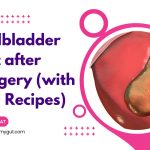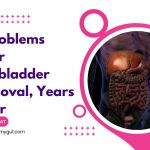Pain Where Gallbladder Was Removed Years Ago? 7 Causes, Doctor Explains.
Our content is not intended nor recommended as a substitute for medical advice by your doctor. Use for informational purposes only.
Pain at the site of gallbladder removal may persist for years after its removal. And it is more common than you think.
Experiencing biliary-type pain after gallbladder removal is a common and well-recognized condition; it is called (postcholecystectomy syndrome).
Postcholecystectomy syndrome affects around 14-34% of people after removing their gallbladder. And it can last for a year.
Pain, where the gallbladder was removed can be due to either:
- Biliary problems such as recurrence of gallstone, sphincter of Oddi dysfunction, bile duct stricture, etc.
- Non-biliary conditions include functional dyspepsia, gastritis, peptic ulcer disease, IBS, or psychological factors.
Today, you will learn the causes and the differences in this article. Ask your doctor about your specific symptoms. This is not a substitute for medical advice from your doctor.
1. Recurrence or missing of gallstones inside the bile ducts.
You can have a gallstone after gallbladder removal, even years later. The gallstones don’t come back inside the gallbladder because they are no longer present.
The possible sites of the gallstones after gallbladder removal are (reference):
- Missed or newly formed gallstone inside the common bile duct (the commonest site).
- Missed stone in the cystic duct (due to incomplete gallbladder removal).
- Newly formed stones in the hepatic ducts (right, left, or common hepatic ducts.
- Newly formed gallstones inside the liver (in the intrahepatic bile ducts).
Symptoms of gallstones after gallbladder removal:
1. Typical gallbladder pain (biliary colics).
The presence of a gallstone inside your bile ducts will result in typical biliary colic (similar to gallbladder pain before its removal).
Newly formed stones can cause typical gallbladder pain. However, the onset of pain can be at any time, even if you had your gallbladder removed years ago.
The symptoms of typical biliary colic are summarized below:
Biliary colic. |
Description |
1. Site |
Usually, The right upper quadrant of your abdomen |
2. Spread |
– The pain may spread to the back of the right shoulder. – Also, it spreads to the epigastric area. |
3. Character |
Constant builds up then disappears gradually. |
4. Duration |
At least 30 minutes. It may last up to 6 hours. |
5. Relation to food |
– Triggered by foods (especially fatty food and large meals. – However, it can start spontaneously. |
6. NOT related to: |
Movement, bowel movements, or the passage of flatus. |
7. Nausea |
Often Present, severe. |
8- Commonly associated symptoms |
|
2. Symptoms of bile duct obstruction.
- Dark-colored urine (very dark yellow or brown urine).
- Clay stool (pale or greyish stool).
- Yellowish discoloration of your eye whites and skin (jaundice).
3. Symptoms of the complications (if present).
The presence of the gallstone can lead to complications other than biliary obstruction.
The two most common complications are acute pancreatitis (severe epigastric pain and vomiting) and infection of the biliary system, called cholangitis (fever, jaundice, and abdominal pain).
Learn more about these complications HERE.
2. Sphincter of Oddi dysfunction.
The common bile duct (CBD) delivers the bile to the duodenum. Then, the CBD unites the pancreatic duct near its end, forming a single duct called (the ampulla of Vater). The ampulla of Vater opens into the duodenum.
The opening is encircled by a ring of muscle called (the sphincter of Oddi). Sphincter of Oddi dysfunction describes the abnormal obstruction of the bile and pancreatic secretions due to abnormal structure or function of the sphincter.
Sphincter of Oddi dysfunction mimics gallbladder pain. It also can cause symptoms of pancreatitis.
It is rare and difficult to diagnose disease. Studies show that women are more affected by SOD than men (reference).
3. Alternative diagnosis.
Other conditions can lead to upper-right or upper-middle abdominal pain that mimics gallbladder pain.
- Peptic ulcer disease and chronic gastritis.
- Irritable bowel syndrome.
- Bone (rib) and abdominal muscle pain.
- Functional dyspepsia.
- Liver pain (due to hepatitis or liver tumors).
- Chronic pancreatitis.
- Inflammation of the pleura (the membrane that envelopes the lungs).
- GERD (acid reflux).
- Anterior cutaneous nerve entrapment syndrome (reference).
The most common conditions that cause pain when the gallbladder is removed years ago are peptic ulcer disease, functional dyspepsia, and IBS.
We discussed the differences in detail in this article: 5 Mimics of Gallbladder Pain, Gastroenterologist Explains.
4. Bile duct narrowing (stricture).
Bile stricture or narrowing due to a previous stone, injury to bile ducts during cholecystectomy, or tumor leads to typical gallbladder pain. Strictures can develop years later after gallbladder removal.
You will experience symptoms similar to bile duct stones (biliary colic, jaundice, and signs of other complications.
Learn more about bile strictures.
5. Psychological factors.
Current or previous history of anxiety, depression, unhappiness, or psychological stress reflects on your gut.
The term (brain-gut axis) is well-established nowadays. For example, anxiety is way more common in IBS sufferers than in the general population.
Psychological factors can lead to upper right abdominal pain for years after getting your gallbladder removed.
6. Wound neuroma.
Wound neuroma results from partial or complete nerve injury during the gallbladder removal operation. The nerve damage can result from a skin wound or gallbladder excision (amputation neuroma).
The damaged nerve can cause pain at the site of gallbladder removal even if it was removed years ago.
Symptoms:
The pain from surgical wound complications is different from the typical biliary colic. Although it is in the exact location in the upper-right abdomen, it has some differences:
- Not related to meals.
- Often accompanied by tenderness over the wound area.
- Constant pain (not in the form of attacks such as gallbladder pain).
- Prolonged; it can last for years.
- Not affected by food or bowel movement.
- However, activity can increase the pain.
MORE: Back Pain After Gallbladder Surgery: Causes & Incidence.
More: Problems after gallbladder removal years later.
- Evidence-based
- Written by a doctor.







